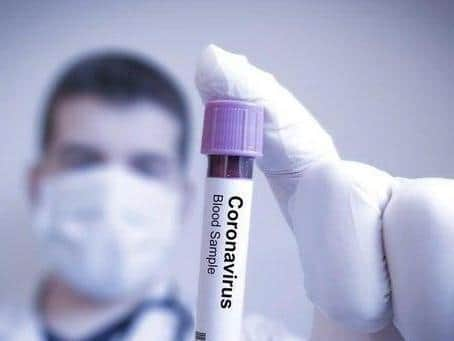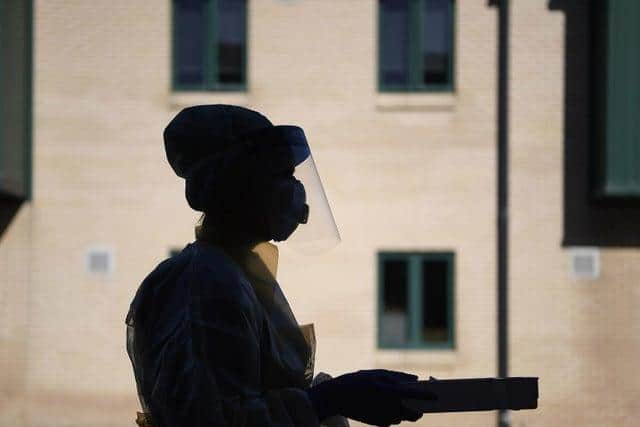13 councils breach WHO five per cent threshold for positive Covid tests ahead of planned June 21 lockdown end date
Last year WHO recommended that governments should ensure the proportion of coronavirus tests coming back positive remains below five per cent for at least two weeks before regions reopen.
The threshold is the maximum limit at which point a pandemic would be considered out of control, although positivity rates would ideally be far lower.


Advertisement
Hide AdAdvertisement
Hide AdThe latest government data shows Yorkshire and the Humber has the second highest rate for positive Covid-19 tests with a rate of 1.9 per cent in the week to 2 June, up from 1.4 per cent per cent a week earlier, while the highest rating of 4.3 per cent was recorded in the North West.
Kirklees stands at having the highest positive rate for positive Covid-19 tests, and the 42nd highest council rating in England with a rate of 3.3 per cent - this is down from one per cent per cent a week earlier.
Bradford follows with 3.2 per cent - up from 0.8 per cent per cent from a week earlier, while Leeds has the third highest in the region and the 51st highest council rating standing at 2.7 per cent - up 1.3 per cent.
While Calderdale ranked in 54th at 2.4 per cent - up 0.8 per cent while Wakefield was 57th with 2.3 per cent - up 0.6 per cent.


Advertisement
Hide AdAdvertisement
Hide AdBut the latest government data shows 13 councils in England had a positivity rate of more than five per cent in the week to 2 June, up from three a week earlier.
All 13 areas were in the North West. One area – Blackburn with Darwen – was more than double the threshold, while Rossendale and Bolton were approaching double.
In Blackburn, the rate increased to 13.6 per cent, up from 8.1 per cent a week earlier. In Rossendale the rate rose from 8.6 per cent to 9.7 per cent and in Bolton it was 9.6 per cent, up from 8.8 per cent.
There were 24 council areas that are now at or above three per cent that have seen an increase of at least one percentage point in the latest week – implying many more areas are moving towards the 5 per cent threshold.
The councils with the top 20 highest positivity rates were:
Advertisement
Hide AdAdvertisement
Hide AdBlackburn with Darwen: 13.6 per cent (up +5.5 on previous week)
Rossendale: 9.7 per cent (up +1.1 per cent)
Bolton: 9.6 per cent (+0.8)
Hyndburn: 8.1 per cent (+4.0)
Ribble Valley: 7.6 per cent (+4.3)
Bury: 6.8 per cent (+3.4)
Manchester: 6.8 per cent (+3.6)
South Ribble: 6.3 per cent (+3.7)
Salford: 6.0 per cent (+2.7)
Stockport: 5.8 per cent (+3.8)
Burnley: 5.7 per cent (+3.1)
Preston: 5.2 per cent (+2.4)
Rochdale: 5.1 per cent (+2.5)
Wigan: 4.9 per cent (+2.3)
Pendle: 4.3 per cent (+1.6)
Trafford: 4.3 per cent (+1.6)
Oldham: 4.2 per cent (+1.6)
Chorley: 3.8 per cent (+1.4)
Tameside: 3.7 per cent (+2.0)
Bedford: 3.6 per cent (+0.6)
The situation across England
The positivity rate across the country was 1.5 per cent in the week to June 1, up from 0.9 per cent a week earlier.
It has almost doubled from 0.8 per cent at the start of May.
But the rate varies significantly across the country, from a low of 0.5 per cent in the South West to 4.3 per cent in the North West.
Advertisement
Hide AdAdvertisement
Hide AdAreas in the North West that have seen clusters of the Delta variant, first identified in India, have been subject to surge testing, which may have increased the number of positive cases that have been identified.
But more testing would also return a higher number of negative results. The high proportion of tests giving positive results suggests coronavirus is far more widespread in these areas than elsewhere in the country.
Prime Minister Boris Johnson has said there is “no question” that coronavirus infections have increased in England.
“We always knew that was going to happen,” he added.
“What we need to work out is to what extent the vaccination programme has protected enough of us, particularly the elderly and vulnerable, against a new surge.”
What does WHO say?
Advertisement
Hide AdAdvertisement
Hide AdWHO set out its five per cent threshold in May last year, long before effective vaccines had been developed and rolled out.
The positivity rate threshold should be used to supplement estimates of the R-number – the rate of the virus’s transmission in communities – to assess whether the epidemic is under control, it said.
In England, 76.4 per cent of people aged 18 and over had had at least one vaccine dose as of 6 June. Across the UK, the figure is 76.8 per cent.
The Yorkshire Post asked WHO if successful vaccination programmes would affect its guidance on test positivity. It has not yet responded.
What does the Government say?
Not much.
Advertisement
Hide AdAdvertisement
Hide AdThe Yorkshire Post approached the Department of Health and Social Care about the latest data.
We asked if it recognised or took the WHO threshold into account, and whether the situation in the North West was cause for concern.
It passed our query to the Cabinet Office, which simply said before taking each step the Government would review the latest data on the impact of the previous step against four tests.
These are the continued success of the vaccine programme, whether evidence shows vaccines reduce hospitalisations and deaths, whether infection rates risk a surge in hospitalisations that would put unsustainable pressure on the NHS, and whether its assessment of the risks has been fundamentally changed by new variants of concern.
It did not address the five per cent threshold directly.
__________
Support The Yorkshire Post and become a subscriber today.
Advertisement
Hide AdAdvertisement
Hide AdYour subscription will help us to continue to bring quality news to the people of Yorkshire. In return, you'll see fewer ads on site, get free access to our app and receive exclusive members-only offers. Click here to subscribe.
Comment Guidelines
National World encourages reader discussion on our stories. User feedback, insights and back-and-forth exchanges add a rich layer of context to reporting. Please review our Community Guidelines before commenting.
